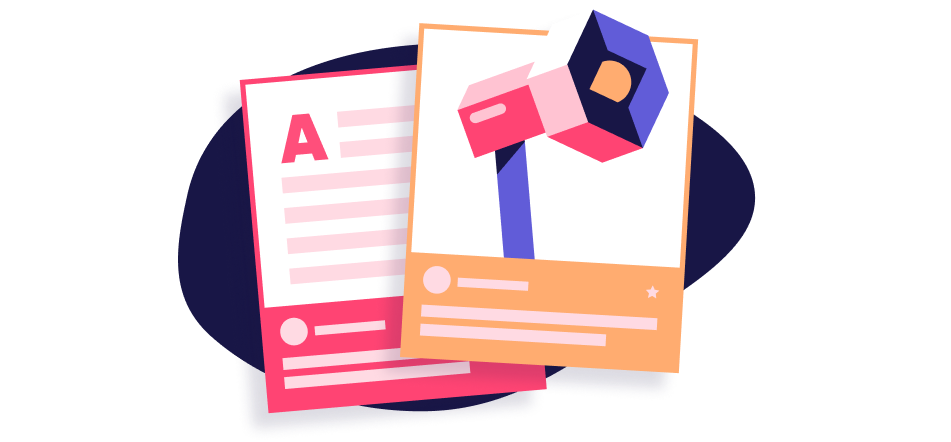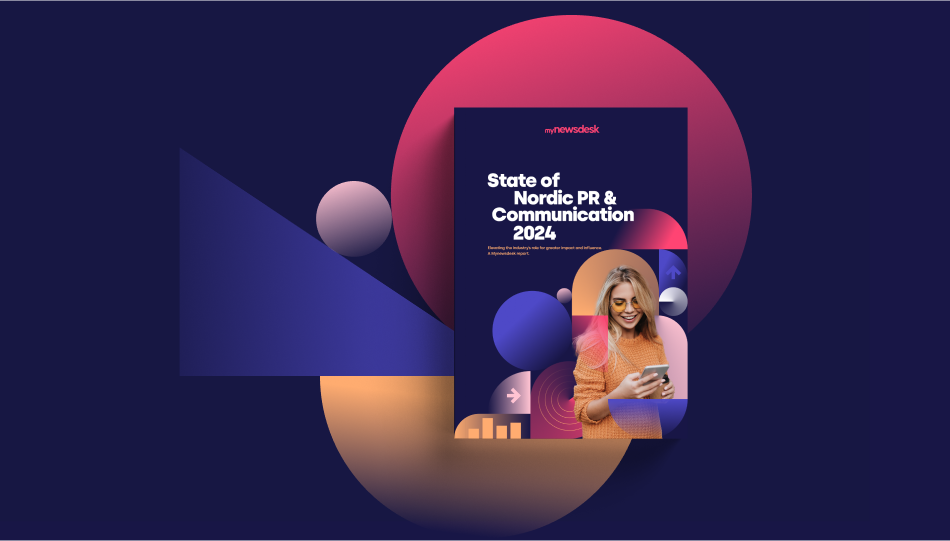How are PR agencies using AI? Will AI replace Public Relations? Will AI replace humans? There are many questions regarding AI right now, but one thing is for sure – the AI revolution is here. So how do you prepare for it?
To some PR professionals and communicators, this new shift may seem scary. If you are asking yourself: “Does the arrival of AI mean I’m no longer needed?”, this blog post will probably calm you down. Instead of thinking of AI as a replacement, we are exploring how AI can help you in your daily work – and when you need to help AI.
How AI can enhance PR efficiency
AI and efficiency go hand in hand, but what about AI and PR? Here are some ways AI can increase PR efficiency:
Generate content quickly
What AI can do:
One of the most time-consuming aspects of PR and communication is content creation. Whether it’s press releases, articles, or social media posts – producing vast amounts of content takes time. Or at least, it used to! With the power of AI, you can now create content in seconds.
What this means for you:
While AI definitely helps out with content creation, it cannot do it all. You still need to act as an editor – proofread, improve it if needed, make sure it aligns with your organization’s values, and so on.
Automate repetitive tasks
What AI can do:
As a PR professional, you probably have some mundane tasks you would rather outsource. Now, AI can do them for you! These include routine processes such as email outreach, data entry, and reporting.
What this means for you:
By letting AI do these, you will have more time to focus on strategic and creative aspects of your work.
Analyze big chunks of data
What AI can do:
Going through vast amounts of data to for example identify trends and provide actionable insights are helpful tasks AI can perform in no time. For example, AI can help you track campaign performance and understand audience behavior, which allows you to make more informed decisions.
What this means for you:
While AI can make suggestions when it comes to how you should act on your data, your human perspective is needed. After all, not all decisions are based solely on data, but also on factors such as your target group’s values, your overall strategic focus, and so on. Ultimately, you’re the one who has to make the data useful!

Can AI produce human-like storytelling?
Now, the discussion about AI and PR becomes really interesting, as this subject is quite complex. As mentioned, AI is amazing when it comes to analyzing data and helping you stay efficient, but it does – of course – lack the depth of human experience and emotions. While AI can create more generic content in an instant, it cannot speak from the heart. Does this affect the content it can create? Or can AI really replace humans?
Storytelling as an art form
There are stories, and then there are stories. Those we carry with us, because they truly make an impact. Great storytelling is not just about conveying information; it’s an art form that engages, inspires, and evokes emotions. As a PR professional, storytelling is vital as it’s all about connecting with your audience. After all, every successful brand has great stories closely tied to them.
If you’ve ever tried creating an impactful content piece, you know how challenging it can be. Oftentimes, the best stories originate from real-life encounters and personal connections. Since every human is unique, it means they bring their own unique perspective to the table when telling a story. Great storytellers possess the ability to craft narratives that are rich in nuance, cultural context, and emotional depth. By using your own experience, chances are you can resonate with your audience on a profound level as they will probably see themselves in you – even if your content piece is narrated from your brand’s point of view. This is challenging for AI to replicate, as it lacks the personal and subjective experiences that drive human emotions.
AI may also struggle with abstract thinking, innovation, and the creation of truly novel concepts. While AI can analyze data to, for example, identify popular topics, human creativity often involves intuition, and the ability to draw connections that extend beyond data. That’s why the human element in storytelling is more likely to include unexpected and imaginative elements than AI generated content. Learn more about creating brand storytelling here!
So – does this mean AI is useless when it comes to storytelling? Definitely not! Here are some ways AI can help you create great stories:
AI as a creative catalyst
What AI can do:
We all know the feeling of staring at a blank page, waiting for amazing ideas to suddenly strike us. Sometimes, they do come! Oftentimes, they do not. This is where AI comes into the picture, as it can help you out with idea generation and even creating initial drafts. By for example asking AI what your audience might be interested in when it comes to a certain topic, you may get a bunch of ideas to choose from.
What this means for you:
While AI can help spark your creativity and even write content pieces for you, infusing your own emotional understanding and human perspective into the draft is what will make it go from a good story – to a great one.
The power of personalization
What AI can do:
Everyone understands how important personalization is to connect with your audience, but it’s usually expensive to execute. Writing 20 different ads or five niche blog posts is clearly more costly than just producing one of each. However, AI can help you cut costs! Based on data-driven insights, AI can generate ideas specifically tailored to niche audiences, and create content around them as well. By cutting costs in the production phase, personalization becomes more affordable.
What this means for you:
To pinpoint a brand’s tone of voice in a text, human touch is usually required. When using AI for content generation, make sure to always proofread and make adaptations. For the essence of your brand to be conveyed, incorporate for example humor, empathy, and cultural nuances that align with your tone of voice. Otherwise, you may risk losing the core of your brand over time.
Is AI funny?
What AI can do:
A great way to relate to your audience is by making them laugh. AI can help you produce funny content such as texts and images – but you have to be specific about what you want.
What this means for you:
While AI can analyze patterns and generate content, understanding the subtleties of humor is challenging. Humor is dependent on so many factors, such as cultural preferences, shared interests and experiences, and so far. Therefore, to create funny content using AI, your human input is required. If there’s a funny trend you want to jump on, you have to provide AI with enough information so it can create content based on it. And – of course – decide if that content actually is funny enough to publish!
Can AI handle unpredictable events?
So far, you’ve probably seen a pattern – AI is great at executing tasks quickly but usually lacks the ability to make strategic decisions. Humans, on the other hand, are flexible, creative, and able to navigate unforeseen circumstances and opportunities that may arise unexpectedly. As a PR professional, your job contains routine tasks as well as unpredictable events. When it comes to the later, these are our tips on how you can cooperate with AI.
Crisis communication
Every PR professional knows how stressful handling a crisis can be. AI can assist you by drafting press releases, providing data-driven insights in real-time, and reaching out to journalists when needed. This gives you the chance to act fast! However, determining the most appropriate course of action during a crisis still requires human judgment. This means your expertise is vital when it comes to navigating the complexities of crisis communication, such as understanding the broader context, assessing potential reputational risks, and making quick decisions that align with the organization’s values. Therefore, you still need to come up with a strategy, but AI can help you make data-driven decisions and then execute your strategy.
Learn more about how to survive a crisis in our guide.
Picking up on trends
Trends come and go quicker than ever, and using them to reach your audience can be a smart move. AI can help you analyze data and thereby identify trends, but it may not understand them. Figuring out what makes certain trends relevant and appealing is usually dependent on context, cultural nuances, and sometimes factors that seem almost impossible to explain. Understanding why something is trending is crucial when it comes to deciding on if this trend suits your organization or not. If it does, AI can assist you in producing trendy content, but you’re the one who has to recognize the trend and make the decision.
Community building
AI can monitor media channels, social platforms, and online forums to track brand mentions and sentiment, which is a great way to understand your audience. Media monitoring helps you proactively manage your reputation and thereby maintain a positive brand image. You can, for example, see if there’s a spike in mentions – whether good or bad. However, you have to make the ultimate decisions when it comes to how to respond to positive or negative feedback, and so forth. It’s your job to make your audience feel seen – AI just makes it easier for you.

Maintaining trust when using AI
AI already plays a significant role in content creation and communication. Some people find this great, and others are skeptical. The idea of losing the human touch can seem scary, and it’s your job to showcase humans are still very much involved. That is why maintaining trust during this AI revolution will be paramount. Here are our best practices to do so.
How to humanize AI content
Staying trustworthy is all about signaling that behind your communication is an actual human or a whole team of people. Therefore, here’s a checklist of must-do’s every time you generate content using AI:
Proofread
AI may produce content in seconds, but it isn’t always of the highest quality. Proofread the text to ensure accuracy and coherence, and to catch grammatical errors and inconsistencies.
Fact check
The way AI can collect information from thousands of sources instantly is extraordinary. However, AI may not always discern between credible and unreliable sources. Therefore, always fact-check any information provided by AI, to verify the accuracy of the information.
Make judgements
AI lacks ethical judgment and may therefore create content that is controversial or even immoral. Therefore, as an editor, you have to be the human judge. Always assess the ethical implications of the content to verify its compatibility with the values and principles of your organization. This is especially critical when dealing with sensitive topics or potential reputational risks.
Personalize
As already mentioned, personalizing your content to ensure it aligns with your organization’s tone of voice and brand values is crucial. That’s what makes your organization unique! Without this step, your content will probably seem generic and therefore not capture your audience.
All in all, you can probably tell that editing AI-generated content is no different from editing human-generated content. The conclusion is therefore to always use an editor whenever you produce content!
Build real relationships
AI can help customers out in the shape of chatbots and similar, and reach out to thousands of journalists in an instant. However, to really connect, there has to be some kind of human interaction. For example, while AI can initiate conversations with relevant people, it’s vital that they can give an actual human a call. When journalists or stakeholders respond to your AI-generated content, it’s essential that you are well-versed in the details. Knowing the specific context, preferences, and references of each contact is crucial, especially if they choose to call you. Otherwise, you will seem unprofessional, which makes building long-term relationships impossible. As a PR professional, you need to form relationships with journalists and industry key players. No matter how refined AI becomes, nothing can replace the feeling of wanting to help out a friend in the industry. Become that friend!
In summary
The AI revolution prompts questions about its role in PR, including concerns about PR professionals and agencies being replaced by AI. However, this blog post emphasizes a collaborative approach, positioning AI as an aid rather than a replacement.
AI enhances PR efficiency by rapidly generating content, automating repetitive tasks, and analyzing data. While AI contributes significantly, the human touch remains essential to ensure content quality, alignment with organizational values, and strategic decision-making.
Regarding storytelling, AI is limited when it comes to capturing the depth of human experiences and emotions. Great storytelling, that engages and inspires, relies on the unique perspectives and emotional depth humans bring. However, AI can be used as a creative catalyst, a tool for personalization and cost-effective content generation.
The same pattern is applicable to crisis communication, trend identification, and community building. While AI helps out with data-driven decisions and quick responses, human expertise is indispensable in navigating complexities, understanding trends’ relevance, and building a positive brand image.
To maintain trust in the era of AI, always proofread, fact-check, make ethical judgments, and personalize content. Also, remember that nothing can replace genuine human connections. That is why building real relationships in PR is vital, because the value of human involvement in the landscape of AI-driven PR cannot be understated.




